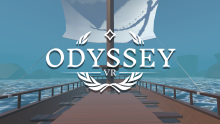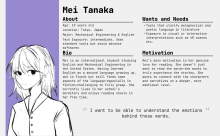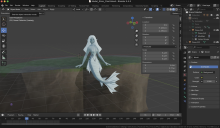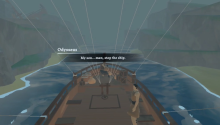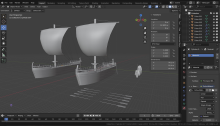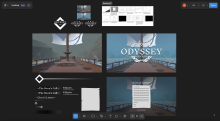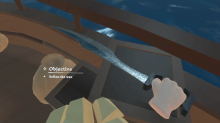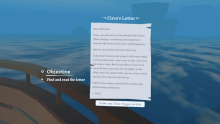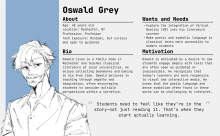An interactive, storytelling virtual reality experience that immerses users in the journey of Homer's Odyssey through the University of Rochester Libraries' summer internship program
About the Experience
This immersive experience reimagines the Sirens scene from Homer’s Odyssey through virtual reality. Created by Emmie Lin ’26, XR Designer and Barbara J. Burger Summer Intern, in collaboration with Professor Nick Gresens from Religion and Classics, the project invites users to step into Odysseus’s perspective as he and his crew navigate perilous waters guided by Circe’s advice.
Emmie researched multiple translations and artistic interpretations of the myth, then used mood boarding, sketching, and storyboarding to shape the look and feel of the experience. Guided by a human-centered design process, she collaborated with Sam Monaghan from iZone to develop user personas representing a range of learner needs and with Vini Romualdo to craft a UX strategy focused on accessibility and engagement. These insights informed the pacing, interactions, and visual storytelling throughout the experience.
She created original 3D assets in Blender and developed the environment and gameplay in Unity. Working with Sound Designer Aleem Griffiths and voice actors, she explored how to interpret the Sirens’ song, layering custom music, voice, and ambient effects to deepen immersion and emotional impact.
Key Features
- Custom 3D assets and animations: Includes an original ship, environment, rigged characters, and interactive objects, all modeled and animated in Blender.
- Immersive soundscape: Features original background music, ambient effects, voice acting, and an interpretive Sirens’ song created in collaboration with sound designer Aleem Griffiths.
- Interactive gameplay: Users complete hands-on tasks such as finding Circe’s letter, cutting and softening wax, and giving it to the crew to protect them from the Sirens’ call.
- User interface design: A diegetic menu system incorporates story elements like the letter from Circe to guide the player.
- Accessibility: Captions and visual cues support inclusive engagement and comprehension for all users.
Why Bring Literature into Virtual Reality?
Odyssey VR explores how immersive technologies can transform the way we experience and understand classic works of literature. The project merges virtual reality and classical storytelling to make The Odyssey more accessible and emotionally resonant for modern audiences.
Students often struggle to engage with texts like The Odyssey because of their archaic language, distant cultural context, and abstract themes. These challenges can be even greater for students learning English as a second language, for whom the complexity of the text and cultural references can create additional barriers to comprehension. By reimagining the story as an interactive experience, users no longer just read about Odysseus’s journey—they live it. They step into his and other characters’ perspectives, make decisions, and face challenges firsthand, deepening their understanding through direct experience.
This approach draws on principles of embodied learning and Extended Mind Theory, suggesting that cognition can extend beyond the brain into physical and environmental interaction. By combining literature, art, mythology, and game design, Odyssey VR invites new forms of learning that enhance comprehension, empathy, and retention.
Ultimately, the project functions as both a creative reinterpretation and an educational tool, designed to help users connect emotionally with the ancient world and inspire renewed curiosity about Homer’s epic.

